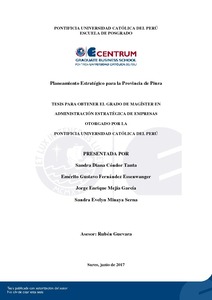| dc.contributor.advisor | Guevara Moncada, Rubén | |
| dc.contributor.author | Cóndor Tanta, Sandra Diana | es_ES |
| dc.contributor.author | Fernández Essenwanger, Emérito Gustavo | es_ES |
| dc.contributor.author | Mejía García, Jorge Enrique | es_ES |
| dc.contributor.author | Minaya Serna, Sandra Evelyn | es_ES |
| dc.date.accessioned | 2017-06-13T20:26:28Z | |
| dc.date.available | 2017-06-13T20:26:28Z | |
| dc.date.created | 2017 | |
| dc.date.issued | 2017-06-13 | |
| dc.identifier.uri | http://hdl.handle.net/20.500.12404/8782 | |
| dc.description.abstract | Este planeamiento estratégico para la provincia de Piura (2016-2026) se elaboró siguiendo la metodología del Modelo Secuencial del Proceso Estratégico de D’Alessio (2015). La provincia de Piura, ubicada en la región del mismo nombre, en el norte del Perú, presenta debilidades: alta informalidad en sus unidades empresariales y un gobierno sin apoyo de la población. Estas debilidades se confrontan con fortalezas como gran cantidad de recursos naturales, y producción de energía para soportar el crecimiento de la manufactura y el turismo. Piura puede desarrollar ventajas competitivas en función de la consolidación de la provincia como destino turístico, al combinar atractivos naturales con infraestructura hotelera, y de la alta importancia que tiene el sector manufacturero a nivel nacional, con productos de valor agregado a partir de insumos agrícolas y pesqueros. Adicionalmente, se ha encontrado que la gestión en el uso del canon minero y el aporte de los hidrocarburos constituyen un factor generador de beneficio social para los ciudadanos. También, existe la unión de la sociedad civil para lograr objetivos comunes a través de distintas asociaciones. Así, debe hacer uso de sus fortalezas, especialmente de sus atractivos naturales, junto con la producción energética y los sistemas de riego que posee. Con la implementación de este plan estratégico se lograrán grandes cambios en un periodo de 10 años: el aumento en el valor agregado bruto, la creación de empleos formales y el aumento del Índice de Desarrollo Humano. Piura se ubicará entre las primeras del país por su competitividad, reduciendo la pobreza, elevando el nivel educativo de su población y, en general, incrementando el acceso a los servicios básicos (agua potable y red de saneamiento). Todo esto se realizará de forma socialmente responsable, preservando los recursos naturales para las futuras generaciones | es_ES |
| dc.description.abstract | This is a strategic planning that has been developed following the methodology of Strategic Process designed by D'Alessio (2015). It aims to Piura province, covering the period 2016 to 2026. This province is located in the region of the same name, in northern Peru. This region has weaknesses such as high informality in their business units and a government that does not have the support of the population, which are confronted with strengths and wealth of natural resources and energy production to support the growth of manufacturing and tourism. The province has the potential to develop competitive advantages, based on four factors, such as the consolidation of the province as a tourist destination, combining natural attractions with hotel infrastructure and the high importance of the manufacturing sector at national level, with products of Value added from agricultural and fishery inputs. Additionally, it has been found that management in the use of mining canon and the contribution of hydrocarbons is a factor generating social benefit for citizens. While there is the union of civil society to achieve common goals, through various associations. Through the implementation of this strategic plan, great changes will be achieved over a 10-year period, such as the increase in gross value added, the creation of formal jobs and the increase in the Human Development Index. The province will be among the first in the country, in terms of competitiveness, reducing poverty, raising the educational level of its population and in general increasing access to basic services such as potable water and sanitation network. All this in a socially responsible way, preserving natural resources for future generations | es_ES |
| dc.language.iso | spa | es_ES |
| dc.publisher | Pontificia Universidad Católica del Perú | es_ES |
| dc.rights | info:eu-repo/semantics/openAccess | es_ES |
| dc.rights.uri | http://creativecommons.org/licenses/by-nc-nd/2.5/pe/ | * |
| dc.subject | Desarrollo regional -- Perú -- Piura | es_ES |
| dc.subject | Planificación regional -- Perú -- Piura | es_ES |
| dc.subject | Planificación estratégica | es_ES |
| dc.title | Planeamiento estratégico para la Provincia de Piura | es_ES |
| dc.type | info:eu-repo/semantics/masterThesis | es_ES |
| thesis.degree.name | Maestro en Administración Estratégica de Empresas | es_ES |
| thesis.degree.level | Maestría | es_ES |
| thesis.degree.grantor | Pontificia Universidad Católica del Perú. CENTRUM | es_ES |
| thesis.degree.discipline | Administración Estratégica de Empresas | es_ES |
| renati.advisor.orcid | https://orcid.org/0000-0002-4795-2557 | es_ES |
| renati.discipline | 413307 | es_ES |
| renati.level | https://purl.org/pe-repo/renati/level#maestro | es_ES |
| renati.type | https://purl.org/pe-repo/renati/type#tesis | es_ES |
| dc.publisher.country | PE | es_ES |
| dc.subject.ocde | https://purl.org/pe-repo/ocde/ford#5.02.04 | es_ES |






